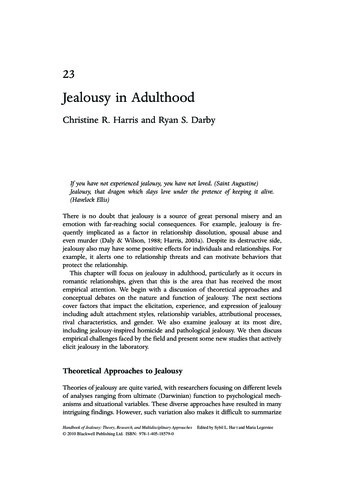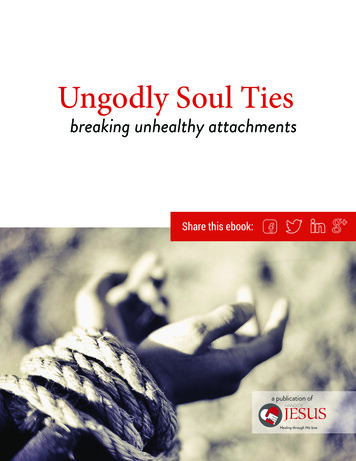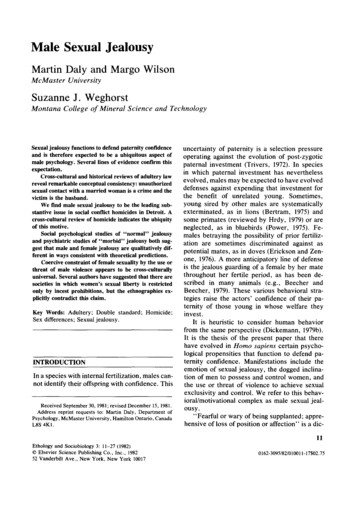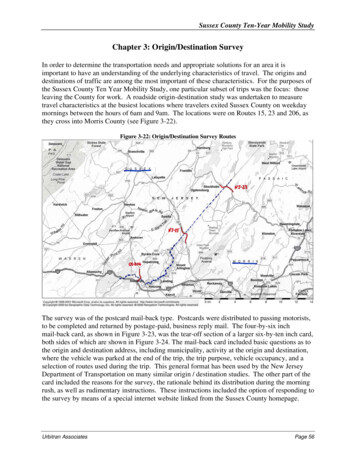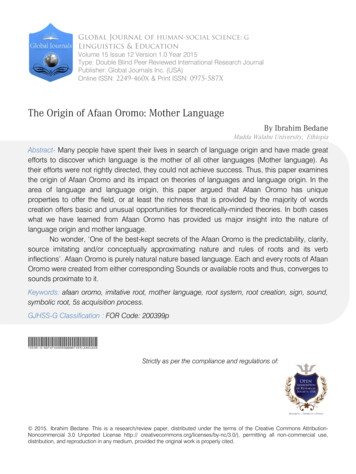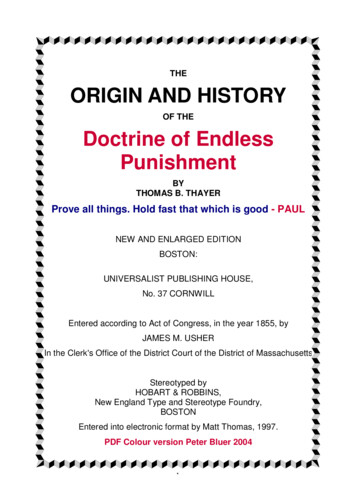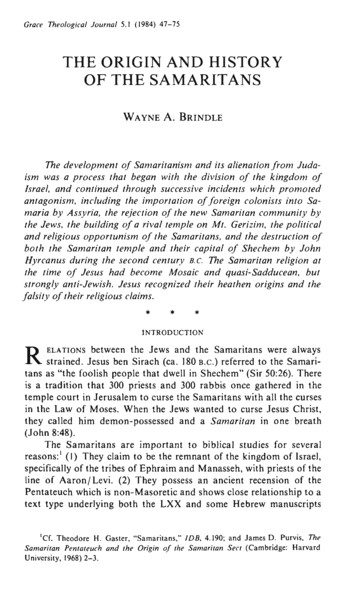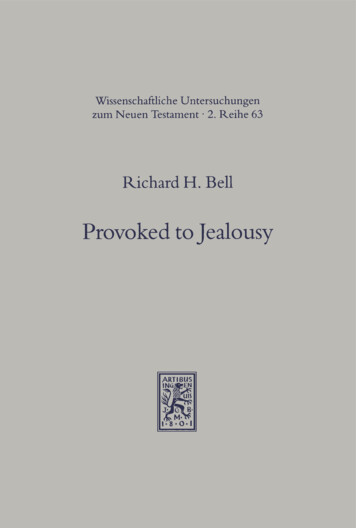
Transcription
Wissenschaftliche Untersuchungenzum Neuen Testament 2. ReiheBegründet von Joachim Jeremias und Otto MichelHerausgegeben vonMartin Hengel und Otfried Hofius63Provoked to JealousyThe Origin and Purpose of theJealousy Motif in Romans 9-11byRichard H. BellJ.C.B. Mohr (Paul Siebeck) Tübingen
Die Deutsche Bibliothek -CIP-EinheitsaufnahmeBell, Richard H.:Provoked to jealousy : the origin and purpose of the jealousymotif in Romans 9-11 / by Richard H. Bell.- T ü b i n g e n : Mohr, 1994(Wissenschaftliche Untersuchungen zum Neuen Testament: Reihe 2 ; 63)978-3-16-157194-7 Unveränderte eBook-Ausgabe 2019ISBN 3-16-146091-XNE: Wissenschaftliche Untersuchungen zum Neuen Testament / 02 1994 J.C.B. Mohr (Paul Siebeck) Tübingen.Das Werk einschließlich aller seiner Teile ist urheberrechtlich geschützt. Jede Verwertungaußerhalb der engen Grenzen des Urheberrechtsgesetzes ist ohne Zustimmung des Verlagsunzulässig und strafbar. Das gilt insbesondere für Vervielfältigungen, Übersetzungen, Mikroverfilmungen und die Einspeicherung und Verarbeitung in elektronischen Systemen.Das Buch wurde von Druck Partner Rübelmann GmbH in Hemsbach auf säurefreies Werkdruckpapier der Papierfabrik Niefern gedruckt und gebunden.ISSN 0340-9570
To my wife
PrefaceThis study is a revised version of a doctoral dissertation accepted bythe Evangelisch-theologische Fakultät der Eberhard-Karls-Universität,Tübingen. Prof. Dr Peter Stuhlmacher supervised my work, and I amgrateful to him not only for his meticulous supervision but also for introducing me to a theological world where historical critical scholarship andChristian faith live happily together. I also wish to thank Prof. Dr MartinHengel and Prof. Dr Otfried Hofius who, as well as kindly accepting thisbook in the WUNT 2 series, have had a decisive influence on mytheological outlook.Prof. Dr Otto Betz kindly gave me much of his time and made manyhelpful suggestions both inside and outside his Kolloquium für Graduierte. I am also grateful to the Revd Dr R.T. France, Principal ofWycliffe Hall, Oxford, for suggesting the topic of this research and thankhim and the Revd Dr A.J.M. Wedderburn of Durham University forhelping me at the beginning of the project.The Rabbis believed that those who study the Torah on their ownbecome foolish. 1 I have not had the misfortune to study the law (or thegospel) on my own and I am grateful to those in Tübingen who have keptme from the paths of folly. From the Evangelisch-theologische Fakultät,I am grateful to the late Prof. Dr H.P. Rüger, Prof. Dr H. Gese, Prof. DrE. Käsemann, Prof. Dr G. Jeremias, Prof. Dr H. Lichtenberger, Prof. DrI.U. Dalferth, Dr D. Kellermann, Dr F.G. Hüttenmeister, Dr W. Elliger,Dr R. Riesner, Dr S. Hafemann, Dr B. Ego, Frau S. Höckele, Herr R.Deines, Herr H.-C. Askani, Dr C. Markschies, Herr K. Seibt, Dr N.Umemoto, Herr F. Avemarie, Herr T. Mann, Frau J. Hauser, Frau C.Eichmüller, Mile I. Hummel, and Mr J. Whitlock. From the Katholischtheologische Fakultät I thank Prof. Dr H.J. Vogt and Dr M. Reiser.From the Fakultät für Kulturwissenschaft, I thank Prof. Dr H. Happ(Philologisches Seminar) and Prof. Dr W. Röllig (Altorientalisches Semi1b. Ber. 63b.
viPrefacenar). My thanks go also to Dr R. Heine of the Institut zur Erforschungdes Urchristentums, Tübingen, Prof. Dr R. Hanhart of Göttingen, and tothe Revd R. Griffith-Jones, Chaplain of Lincoln College, Oxford. TheRevd Dr W. Riggans of All Nations College read through an earlier version, Dr W.S. Campbell of Westhill College, Selly Oak, Birminghamhelped in some proof reading, and my colleagues in Nottingham, Mr E.Ball and Dr C. Trueman, did some checking of the bibliography andindices. Then what I thought was going to be the final version was corrected by Mr J. Hodges of Tübingen. Prof. Dr G. Schubring, formerlyon the staff of the Zentrum für Datenverarbeitung, Tübingen, Dr U.Heckel, and Herr H. Strecker helped in solving various computer problems, and Herr J. Renz and Herr C. Landmesser produced a preliminarylaser print out. Mr T. St Quintin of Nota Bene (UK) advised me on someof the subtleties of Nota Bene software, especially in the final stages ofproducing the camera-ready copies.The research was carried out in the wonderful setting of the Evangelisches Stift in Tübingen. One can hardly have a better place to studytheology, and I thank the students and academic and domestic staff fortheir support and sense of humour. I particularly record my thanks to theexcellent libraries of the Evangelisches Stift, of the Evangelischtheologisches Seminar, and of the Eberhard-Karls-Universität Tübingen.The present work was mainly supported by Diakonisches Werk derEKD. I am also grateful for the financial help I received from TyndaleHouse, Cambridge, from the All Saints Educational Trust, London, fromthe Bishop of Edmonton, and from the Board of Mission and Unity of theGeneral Synod of the Church of England. I also thank the Goethe Institutfor a grant to study German at the Goethe Institut, Boppard am Rhein.Many Christian friends have helped me during my four years inTübingen, and I want to make a special mention of Herr Dr Günter andFrau Suzanne Richter and the Church that meets in their house. Finally,my special thanks go to my Mother for her prayers that one day this bookwould be completed and to my wife, Beata, for her love, support, andpatience.I hope that this work will contribute to the scholarly debate on Romans9-11; but I also hope it will do more than that. A major issue facingmany Churches is the relationship of Christianity to Judaism. My interest
Prefaceviiin this relationship was partly stimulated by a curacy I did in Edgware,Diocese of London (Church of England) where about 10,000 of the20,000 people living in the parish were Jewish. The interpretation of theOld Testament, God's purposes for the Jewish people and Christian mission to Jews were live issues for our Church. I hope that my book willgo some way towards clarifying these issues for Christians today.May, 1993NottinghamRichard H. Bell
Table of ContentsPrefacevAbbreviationsxvChapter 1 : Introduction to the Jealousy Motif1. Problems of the jealousy motif112. The importance of the jealousy motif in Romans 9-11 and the need forfurther research33. The meaning of irapafrjXoDe53.1. The meaning of the word jealousy (Eifersucht)53.2. The use of the X3p word field in the Old Testament, Qumran, andRabbinic literature83.3. The use of the fijX- word field in the LXX and Classical literature243.4. The frX- word field in the NT253.5. The meaning of vapa.Çr\hovv273.5.1. The meaning of irapafaKovvgiven in LSJ3.5.2. KctpaÇrfKovv in the LXX3.5.3. The meaning of irapafaKovv in the Pseudepigrapha2727343.5.4. TapafijXùxnç in Philo343.5.5. i r a p a X o v v in the Patristic literature353.5.6. trapa rikoiiv in Paul393.5.7. The translation of irotpaft\ovi in the Old Latin and Vulgate423.6. ConclusionChapter 2: Introduction to Romans 9-1143441. The place of Romans 9-11 in the letter and the theme of 9-11442. The consistency of Romans 9-11563. The question of Heilsgeschichte584. The historical background to Romans 9-11634.1. The Church in Rome644.1.1. Jewish Christians724.1.2. Gentile Christians76
ContentsX4.2. Paul's situation5. The structure of Romans 1-16 and 9-11Chapter 3: Exegesis of Romans 10.14-217879811. Analysis and theme of Romans 9.30-10.21812. The problem of Romans 10.19823. Romans 10.14-18833.1. Romans 10.14-15873.2. Romans 10.16893.3. Romans 10.17923.4. Romans 10.18933.5. Romans 10.193.6. Romans 10.20-214. Conclusion of the exegesis of Romans 10.14-21Chapter 4: Exegesis of Romans 11.1-32951041061071. Analysis of Romans 11.1-361072. Romans 11.1-101073. Romans 11.11-151084. Romans 11.16-241185. Romans 11.25-321265.1. Romans 11.25-271285.2. Romans 11.28-291455.3. Romans 11.30-311475.4. Romans 11.32151Chapter 5: The Jealousy Motif in Romans 9-111. Introduction1541542. The jealousy motif in Romans 101543. The jealousy motif in Romans 111564. Jealousy in the rest of the New Testament166Chapter 6: The Theological Grounds for Jealousy1681. Introduction1682. Has the Church taken Israel's place?1682.1. Romans 2.25-291692.2. Romans 3.1-41712.3. Romans 9.1-51722.4. Romans 9.6-131792.5. Romans 3.9, Romans 3.22 and Romans 10.12180
Contents2.6. The extension of Israel's privileges3. Other grounds for jealousyxi1811843.1. The exchange of roles and the problem of Israel'sworks-righteousness1843.1.1. Romans 9.24-291853.1.2. Romans 9.30-10.131863.1.3. Excursus on the question of Israel's works-righteousness1913.2. The Christian's freedom from the law1933.3. The re-forming of God's image in Christians1964. Relationship of the Church to Israel1975. Conclusions198Chapter 7:Deuteronomy 32 and the Origin of the Jealousy Motif inRomans 9-112001. Introduction2002. Paul's use of the Old Testament2012.1. The "Testimony Book Hypothesis" of Rendel Harris2012.2. The theory of C.H. Dodd2042.3. Criticism and defence of Dodd2053. The Song of Moses in Jewish and Christian tradition2093.1. The Song in its Old Testament context2093.2. The structure of the Song2123.3. The relationship of the Song to the rest of the Old Testament2143.4. The Song in the Dead Sea Scrolls2173.5. The Song of Moses in the Apocrypha2213.5.1. Ben Sirach2213.5.2. The Books of Maccabees2233.6. The Song of Moses in the Pseudepigrapha2243.7. The Song of Moses in Philo and Josephus2253.7.1. Philo2253.7.2. Josephus2273.8. The use of the Song of Moses in Jewish and Christian Liturgy2273.8.1. Jewish liturgy2273.8.2. Christian liturgy2293.9. The place of Deuteronomy 32 in the Rabbinic literature2303.9.1. Introduction2303.9.2. Sifre Deuteronomy2313.9.2.1. Introduction and date2313.9.2.2. Structure2323.9.2.3. Theology of Sifre Ha'azinu233
xiiContents3.9.2.3.1. Election2333.9.2.3.2. Fall and judgement2353.9.2.3.3. Salvation2363.9.2.3.4. Eschatological elements2373.9.2.4. Parallels between Sifre Ha'azinu and Romans 9-113.9.2.4.1. The no-people2402403.9.2.4.2. God's glorification through the exodus2403.9.2.4.3. The "Völkerwallfahrt"2413.9.2.4.4. The salvation of Israel2413.9.2.5. Conclusion3.9.3. Deuteronomy 32 in the Targumim2432443.9.3.1. Moses and Isaiah: witnesses against Israel2443.9.3.2. The jealousy motif2443.9.3.3. The covenant with the Patriarchs2453.9.3.4. Eschatology2463.10. Deuteronomy 32 in the Samaritan literature2473.11. The Song of Moses as an eschatological Song2483.12. The Song of Moses in the New Testament2513.12.1. The Song of Moses in the Theology of Paul3.12.1.1. 1 Corinthians 10.1-222512513.12.1.2. Philippians 2.152553.12.1.3. Romans 12.192563.12.1.4. Romans 15.103.12.2. The use of the Song in the rest of the New Testament2592623.12.2.1. Hebrews 1.62623.12.2.2. Hebrews 10.302633.12.2.3. Revelation 6.10 and 19.22643.12.2.4. Revelation 15.3-42653.12.2.5. Matthew 17.17, Luke 9.41 and Acts 2.402663.12.2.6. Mark 8.37 and 10.452673.12.3. Conclusion2693.12.4. The Song of Moses in Romans 9-112693.12.4.1. Romans 10.192693.12.4.2. Romans 11.11-142713.12.4.3. Salvation of Israel in Romans 11.15, 11.26-272723.12.4.4. Resurrection in Romans 11.152753.12.4.5. Romans 9.4-52753.12.4.6. Romans 9.6-132763.12.4.7. Romans 11.28277
Contentsxiii3.12.4.8. Romans 9.30-332783.12.4.9. Romans 11.16a2783.12.4.10. Linguistic similarities2793.12.4.11. Broader aspects of the influence of Deuteronomy 322803.13. Deuteronomy 32 in the Patristic literature2814. Conclusion284Chapter 8: The Jealousy Motif and the Experience of Paul2861. Introduction2862. Paul before his call2872.1. Was Paul jealous of Christians before his call?2882.2. Was Paul jealous for God?2.3.Paul'spre-Christian jealousy301and the jealousymotifinRomans 9-113. The mission of Paul3.1. Acts 5.173093113113.2. Acts 13.453123.3. Acts 17.53173.4. Acts 9.23-303193.5. Acts 14.1-73203.6. Acts 14.193213.7. Acts 17.13-143223.8. Acts 18.6, 12-173233.9. Acts 19.93243.10. Evaluation of Luke's description of Jewish opposition toPaul's mission3.11. Excursus on God-fearers4. Origin of the jealousy motif through divine revelation3253273284.1. Revelation through the Damascus Road experience3294.2. Revelation subsequent to Paul's call332Chapter 9: The Goal of the Jealousy Motif3361. The jealousy motif and Paul's mission strategy3362. The collection3443.Comparison of Paul's mission strategy with that of theJerusalem apostles3464. The relevance of the jealousy motif for the Church today and the questionof mission to Jewish peopleChapter 10: Conclusions350358
xivContentsBibliography1. Primary sources3633631.1. Bible3631.2. Apocrypha, Pseudepigrapha and Hellenistic Jewish literature3641.3. Qumran literature3651.4. Rabbinic literature3651.5. Early Christian literature3681.6. Gnostic literature3701.7. Greek and Roman literature3702. Reference works and exegetical aids3723. Secondary literature377Index of Authors417Index of References428Index of Subjects and Names463
Abbreviations1. Biblical booksThe abbreviations used for books of the OT, NT and Apocrypha will be readilyunderstood.2. Pseudepigrapha and Early Christian Writings2 Bar.3 Bar.1 En.3 En.Jub.Apoc. MosesPs. Sol.Test. Sim.Test. Jud.Test. Zeb.Test. Ben.Test. JobBarn.1 Clem.Ign. Magn.Ign. Philad.Herrn.Sib.Syriac Apocalypse of BaruchGreek Apocalypse of Baruch1 Enoch3 EnochJubileesApocalypse of MosesPsalms of SolomonTestament of SimeonTestament of JudahTestament of ZebulunTestament of BenjaminTestament of JobEpistle of Barnabas1 ClementIgnatius, Letter to the MagnesiansIgnatius, Letter to the PhiladelphiansShepherd of HermasSibylline Oracles3. Dead Sea ScrollsCD1QHlQpHab1QM1QS4QFlor4QpNah4QTestDamascus DocumentHymns of ThanksgivingPesher HabakkukWar ScrollCommunity RuleFlorilegiumPesher NahumTestimonia
Abbreviationsxvi4. TargumimTarg. Onk.Targ. Neof.Targ. Yer. ITarg. Yer. IITargum OnkelosTargum Neofiti ITargum Yerushalmi I (otherwise known as the Targum of Palestineor Pseudo-Jonathan)Targum Yerushalmi II (otherwise known as the Jerusalem Targumor Fragment Targum)5. Tractates of the Mishnah, Tosephta, Babylonian andPalestinian TalmudimFor the Tosephta, Babylonian and Palestinian Talmudim the letters t., b. and y. areplaced before the tractate respectively.AbothAbod. Zar.Bab. Bat.Bab. Met.Ber.Git.Hal.Ket.Kid.Mak.Meg.Men.M. thAbodah ZarahBaba BathraBaba MegillahMenahothMoed ithYebamothYomaZebahim6. MidrashimGen. R.Ex. R.Lev. R.Num. R.Dt. R.Mek. Ex.Mek. R. Sim.Sifre Dt.Midrash Genesis RabbahMidrash Exodus RabbahMidrash Leviticus RabbahMidrash Numbers RabbahMidrash Deuteronomy RabbahMekhilta ExodusMekhilta R. Simeon ben YohaiSifre Deuteronomy
AbbreviationsSifre Num.Midr. Ps.Midr. SgMidr. Tanh.Leq. t.Pes. R.xviiSifre NumbersMidrash on the PsalmsMidrash on the Song of SongsMidrash Tanhuma (Midr. Tanh. B. Midrash Tanhuma (Buber))Leqach tobPesikta Rabbati7. Reference worksAGANRWBABAGBDBBDFBDREJudGKIBIDBArs Graeca: Griechische Sprachlehre, neu bearbeitet von R.Mehrlein, F. Richter, W. Seelbach und O. Leggewie, Paderborn:Ferdinand Schöningh 5 1981H. Temporini and W. Haase (ed.), Aufstieg und Niedergang derrömischen Welt, Berlin/New York: Walter de Gruyter 1972ff.W. Bauer, Wörterbuch zum Neuen Testament, Berlin/New York:Walter de Gruyter «1988 (bearbeitet von K. und B. Aland)W. Bauer, W.F. Arndt, and F.W. Gingrich, Greek-English Lexiconof the New Testament, Chicago and London: University of ChicagoPress 1961F. Brown, S.R. Driver, and C.A. Briggs, A Hebrew and EnglishLexicon of the Old Testament based on the Lexicon ofW. Gesenius,Oxford: Clarendon Press 1978 (repr.)F. Blass and A. Debrunner, A Greek Grammar of the New Testament, translated and revised by R.W. Funk, Chicago/London:University of Chicago Press 1961F. Blass and A. Debrunner, Grammatik des neutestamentlichenGriechisch, bearbeitet von Friedrich Rehkopf, Göttingen: Vandenhoeck & Ruprecht 151979Encyclopaedia Judaica, 16 vols, Jerusalem: Keter Publishing House1978 (repr.), ('1971-72)E. Kautzsch, (ed.), Gesenius' Hebrew Grammar ET, Oxford:Clarendon Press 2 1910 (revised by A.E. Cowley)G.A. Buttrick (ed.), The Interpreter's Bible, 12 vols, NewYork/Nashville: Abingdon-Cokesbury Press 1952-57G.A. Buttrick (ed.), The Interpreter's Dictionary of the Bible, 4vols, New York/Nashville: Abingdon-Cokesbury Press 1962IDBSupSupplementary volume to IDB, 1976JastrowMarcus Jastrow, A Dictionary of the Targumim, the Talmud Babliand Yerushalmi, and the Midrashic Literature, 2 vols, New York:Pardes Publishing House 1950L. Koehler and W. Baumgartner, Lexicon in Veteris Testamentilibros, Leiden: E.J. Brill 1953L. Koehler, W. Baumgartner, and J.J. Stamm, Hebräisches undKBKBSAramäisches Lexikon zum Alten Testament, 3 vols, Leiden: E.J.Brill 1967-83
XV111AbbreviationsLPGLG.W.H. Lampe (ed.), Patristic Greek Lexicon, Oxford: ClarendonPress 1961-68LSJH.G. Liddell and R. Scott, Greek-English Lexicon, Oxford:Clarendon Press 1985 (revised by H.S. Jones and R. McKenzie witha Supplement 1968)LThKJ. Höfer and K. Rahner (ed.), Lexikon für Theologie und Kirche, 11vols, Freiburg: Herder 1957-67NIDNTTColin Brown (ed.), The New International Dictionary of New Testament Theology, 3 vols, Exeter: Paternoster Press 1975-78PWPaulys Realencyclopädie der classischenAltertumswissenschaft,Neue Bearbeitung von Georg Wissowa, Wilhelm Kroll, Karl Mittelhaus et al., Stuttgart: Alfred Druckenmüller Verlag 1894ff., 2.Reihe 1914ff.Supplement to PW, 1903ff.PWSupStephanusHenri Stephanus, Thesaurus Graecae linguae, 8 vols, ed. by K.B.Haase and W. and L. Dindorf, Paris: Didot 1831-65.3RGGKurt Galling (ed.), Die Religion in Geschichte und Gegenwart:Handwörterbuch jur Theologie und Religionswissenschaft (UTB), 7vols, Tübingen: J.C.B. Mohr (Paul Siebeck) 1986 (repr.), (31959)TDNTG. Kittel and G. Friedrich (ed.), Theological Dictionary of the NewTestament ET, 10 vols, Grand Rapids, Michigan: Wm. B.Eerdmans 1964-76ThWATG.J. Botterweck and H. Ringgren (ed.), Theologisches Wörterbuchzum Alten Testament, 6 vols, Stuttgart/Berlin/Köln/Mainz: W.Kohlhammer 1973-89ThWNTG. Kittel and G. Friedrich (ed.), Theologisches WörterbuchNeuen Testament, 10 vols, Stuttgart: W. Kohlhammer 1933-78zumTREG. Krause and G. Müller (ed.), Theologische Realenzyklopädie,vols, Berlin/New York: Walter de Gruyter 1977-88178. sed VersionBibliothek der Griechischen LiteraturBiblia Hebraica StuttgartensiaBibliothek der KirchenväterDie Bekenntnisschriftender evangelisch-lutherischenKirche,Göttingen: Vandenhoeck & Ruprecht 101986Calvin's CommentariesCoipus Christianorum, Series LatinaJ.B. Frey (ed.), Corpus Inscriptionum ludaicarum, 2 vols, Rom:Pontificio Istituto di Archeologia cristiana 1 1936; 2 1952Corpus Inscriptionum Latinarum, Berlin 1893-1934Corpus Inscriptionum Regni BosporaniCorpus Scriptorum Ecclesiasticorum Latinorum
VRVGNTDie griechischen christlichen Schriftsteller der ersten drei JahrhunderteJerusalem BibleJüdische Schriften aus hellenistisch-römischer ZeitLibrary of Christian ClassicsLoeb Classical LibraryJ.-P. Migne, Patrologia GraecaJ.-P. Migne, Patrologia LatinaNew English BibleNicene and Post-Nicene Fathers of the Christian ChurchOxford Classical TextsPatristische Texte und StudienRevised Standard VersionRevised VersionUnited Bible Societies' Greek New Testament9. PRBRechSRxixAnnual of the Swedish Theological InstituteAnglican Theological ReviewBiblical ArchaeologistBulletin of the American Schools of Oriental ResearchBiblicaBulletin of the John Rylands Library, University ofManchesterThe Bible TranslatorBiblical Theology BulletinBerliner Theologische ZeitschriftBiblische ZeitschriftCatholic Biblical QuarterlyEvangelische TheologieExpository TimesHeythrop JournalHarvard Theological ReviewHebrew Union College AnnualThe Israel Museum JournalJahrbuch für Antike und ChristentumJournal of Biblical LiteratureJournal of Jewish StudiesJournal of ReligionJournal of Semitic StudiesJournal of Theological StudiesJudaicaKerygma und DogmaNovum TestamentumNew Testament StudiesOrientalia Christiana PeriodicaRevue bibliqueRecherches de science religieuse
USQRVFVTZAWZNWZKThZThKAbbreviationsRevue de QumranRivista degli studi orientaliReformed Theological ReviewSvensk Exegetisk ArsbokSitzungsberichte der Heidelberger Akademie der Wissenschaften,Philosophisch- historische KlasseScottish Journal of TheologyStudia TheologicaTyndale BulletinTheologische BeiträgeTheologische LiteraturzeitungTheologische RundschauTheologische Studien und KritikenTheologische ZeitschriftUnion Seminary Quarterly ReviewVerkündigung und ForschungVetus TestamentumZeitschrift für die alttestamentliche WissenschaftZeitschrift für die neutestamentliche WissenschaftZeitschrift für katholische TheologieZeitschrift für Theologie und Kirche10. tionesHumanarum LitterarumAnchor BibleAachener Beiträge zu Pastoral- und BildungsfragenAbhandlungen zum christlich-jüdischen DialogAbhandlungen des deutschen Archäologischen Instituts Kairo, koptische ReiheArbeiten zur Geschichte des antiken Judentums und desUrchristentumsArbeiten zur Literatur und Geschichte des hellenistischen JudentumsAnalecta BiblicaArbeiten zum Neuen Testament und JudentumAramaic BibleDas Alte Testament DeutschAbhandlungen zur Theologie des Alten und Neuen TestamentsAmerican Theological Library AssociationAmerican University Studies, Series 7: Theology and ReligionArbeiten zur TheologieBibliotheca Ephemeridum Theologicarum LovaniensiumBeiträge zur evangelischen TheologieBeiträge zur Förderung christlicher TheologieBeiträge zur historischen TheologieBiblica et OrientaliaBrown Judaic StudiesBiblischer Kommentar: Altes Testament
SupNTDNTLNTOAxxiBlack's New Testament CommentariesBerichte über die Verhandlungen des Sächsischen Akademie derWissenschaften zu Leipzig, Philologisch-historische KlasseBeihefte zur Zeitschrift für die alttestamentliche WissenschaftBeiträge zur biblischen Exegese und TheologieCentury BibleContemporary Christian StudiesCambridge Commentaries on Writings of the Jewish and ChristianWorld 200BC to AD200Cambridge Greek Testament CommentaryCambridge Philological SocietyCambridge Philological Society, Supplementary VolumeCompendia rerum Iudaicarum ad Novum TestamentumEuropäische Hochschulschriften, Reihe 23: TheologieExegetisches Handbuch zum Alten TestamentEvangelisch-katholischer Kommentar zum Neuen TestamentÉtudes bibliquesForschungen zur Religion und Literatur des Alten und Neuen TestamentsForschung zur BibelGöttinger theologische ArbeitenHandbuch zum Alten TestamentHandbuch zum Neuen TestamentHerders theologischer Kommentar zum Neuen TestamentHermeneutische Untersuchungen zur TheologieInternational Critical CommentaryJudaica et ChristianaJournal for the Study of the New Testament Supplement SeriesKommentar zum Alten TestamentMeyers kritisch-exegetischer Kommentar über das Neue TestamentKommentar zum Neuen TestamentThe Library of Biblical StudiesLectio DivinaMissionswissenschaftliche ForschungenMoffatt New Testament CommentaryMonographische Reihe von 'Benedictina': Biblisch-ökumenischeAbteilungMarburger theologische StudienMarshall's Theological LibraryNew Century BibleNew Clarendon BibleDie Neue Echter Bibel: Kommentar zum Neuen TestamentNew International Commentary on the New TestamentNew International Commentary on the Old TestamentNew International Greek Testament CommentaryNew London CommentaryNovum Testamentum SupplementsDas Neue Testament DeutschNew Testament LibraryNovum Testamentum et Orbis Antiquus
NTWUNTYJSZBKAbbreviationsOrbis Biblicus et OrientalisOrbis Biblicus et Orientalis Subsidia DidacticaOxford Bible SeriesOld Testament LibraryPorta Linguarum OrientaliumPapyrologische Texte und AbhandlungenProphezei: Schweizerisches Bibelwerk für die GemeindePseudepigrapha Veteris Testamenti GraeceQuaestiones DisputataeRegensburger Neues TestamentStudien zum Alten und Neuen TestamentStudies in the Bible and Early ChristianitySociety of Biblical Literature Dissertation SeriesStudies in Biblical TheologyStudies in Christianity and JudaismStudies and DocumentsStudies in Judaism and Late AntiquityThe Schiff Library of Jewish ClassicsStudiorum Novi Testamenti AuxiliaSociety for New Testament Studies Monograph SeriesSemitic Study SeriesStudien zum Neuen TestamentStudien zur Umwelt des Neuen TestamentsStudia in Veteris Testamenti PseudepigraphaTheologische BüchereiTheologische Existenz heuteTheologische ForschungTheologischer Handkommentar zum Neuen TestamentTheologische StudienTyndale New Testament CommentariesTrinity Press International New Testament CommentariesTexts and Studies of the Jewish Theological Seminary of AmericaTexte und Untersuchungen zur Geschichte der altchristlichen LiteraturUni-TaschenbücherVeröffentlichungen aus dem Institut Kirche und JudentumVetus Testamentum SupplementsWord Biblical CommentaryWestminster CommentariesWissenschaftliche Monographien zum Alten und Neuen TestamentWissenschaftliche Untersuchungen zum Neuen TestamentYale Judaic SeriesZürcher Bibelkommentare
Chapter 1Introduction to the Jealousy Motif1. Problems of the jealousy motifJealousy is usually a negative idea. Schleiermacher is attributed withthe aphorism: "Eifersucht ist eine Leidenschaft, die mit Eifer sucht, wasLeiden schafft". 1 Kierkegaard writes of jealousy: "Es ist eine düstreLeidenschaft, ein Ungeheuer, welches die Speise, die es nährt, besudelt". 2 Likewise, Iago warns Othello of the dangers of jealousy:O, beware, my lord, of jealousy;It is the green-eyed monster, which doth mockThe meat it feeds on.3In contrast to the great Elizabethan playwright, the apostle Paul, as far aswe know, was not greatly concerned about jealousy in the context of marriage. The jealousy motif in Rom. 9-11, rather, concerns the jealousy ofnon-Christian Jews for the Gentile Christians. This motif occurs explicitly in three verses in these chapters:10.19:¿t\\a Xsyu, [ii] '\apctifh OVK E-yva\ irp&Toq Muüffr/g¿70) irotpafyXaowvftaq sir' OVK EOVEI,vptaq.¿7r' 'eOvel äovvETLö irapopytw11.11:Aeyco ovu, fiij siTTatoav 'CvaTTEOWOLV,avTÜv irapairTcl)[ioiTL 77 owTqpia roiqirupa Tfh&ocaaiirovq.11.13-14:1/xt) JEVOLTO'EBVEOLVeigXsysräXXato TO'Tfiiv 8e Xsyu rolq EOVEOLV ¿4 ' 'OOOP FISV ovu EIFIL ¿yd) EOV&VCLirooToXoq, TT)V biaKOviav fiov Sogafo , (14) E'C ircoq wapafyXaoußov rfiv oäpica Kai owoa nuaqavT&p.This is quoted in A. Jepsen, "Beiträge zur Auslegung und Geschichte desDekalogs", ZAW19 (1967) 288 (277-304).2Stadien auf dem Lebensweg (Gesammelte Werke 15, trans. by E. Hirsch),Düsseldorf/Köln 1958, p. 141.3William Shakespeare, Othello Act 3 scene 3.
2Problems of the jealousymotifA number of problems are raised by these verses and their context. First,what is it that Israel did not understand (Rom. 10.19a) and how does thequotation from Dt. 32.21b answer Paul's question in Rom. 10.19a? Second, what is the meaning of the verb TrapafaXovv in these three verses?Does it mean to provoke to anger, to jealous anger, to envy, or to emulation? Does the meaning in 10.19 differ from that in Rom. 11.11, 14?4Third, Paul's whole argument that the provocation of Israel to jealousy byhis Gentile mission will lead to the salvation of Israel has perplexedseveral commentators. Dinkier writes that Rom. 11.14 "einer psychologisierenden Dialektik der Geschichte nahekommt". 5 C.H. Dodd, commenting on Rom. 11.13-14, writes: "He certainly did make them jealous,but if he really thought that it would have any such desirable result, hewas a great optimist! It is not likely that he felt this to be his motive tomissionary work except for the moment under the stress of his presenttrain of thought". 6 The fourth problem raised by these verses is that it isnot clear how the provocation to jealousy is related to the final salvationof Israel referred to in Rom. 11.26a (/cm OUTOM; TRAG 'lopuriXowOrjoerai)A further question I shall tackle is this: how did Paul come to the ideathat Israel would be provoked to jealousy? Did he come to the ideathrough his study of Dt. 32? Or is the origin of the motif to be found insome special revelation given to Paul, a revelation on the Damascus roador some subsequent revelation? Or did Paul's own experience lead him tothe idea of the jealousy making? This leads to two further questions.First, was Paul jealous of Christians before his call, 7 and was this jealousy a factor leading to his call? Second, did Paul observe Jewish jealousy of Gentile Christians in his mission? The present work will attemptto deal with these problems.4See, for example, the NEB: TapafaXovu is taken to mean "to stir to envy" inRom. 10.19 but "to stir to emulation" in 11.11, 14. Somewhat similar is Die Bibelnach der Übersetzung Martin Luthers mit Apokryphen, Stuttgart 1984: irapafaXovp istranslated as "eifersüchtig machen" in Rom. 10.19 but as "nacheifern" in 11.11 and"zum Nacheifern reizen" in 11.14.5E. Dinkier, "Prädestination bei Paulus: Exegetische Bemerkungen zum Römerbrief", in Signum Crucis: Aufsätze zum Neuen Testament und zur christlichenArchäologie, Tübingen 1967, 260 (241-69).67C.H. Dodd, The Epistle of Paul to the Romans, London121949 (U932), p. 177.Paul would not be jealous of Gentile Christians for, as far as we know, therewere none at the time of Paul's persecution activity (Paul's conversion most likelytook place within 1
Chapter 7: Deuteronomy 32 and the Origin of the Jealousy Motif in Romans 9-11 200 1. Introduction 200 2. Paul's use of the Old Testament 201 2.1. The "Testimony Book Hypothesis" of Rendel Harris 201 2.2. The theory of C.H. Dodd 204 2.3. Criticism and defence of Dodd 205 3. The
